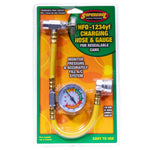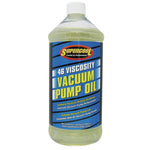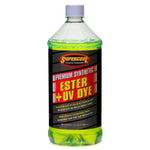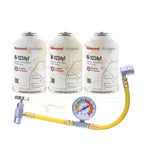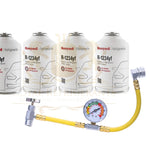You have no items in your shopping cart.

Mixing refrigerants might seem like a quick fix, but it can cause big problems. The R-410A refrigerant is made to work on its own and should never mix with others. This blog explains why mixing R-410A can harm your HVAC system and what you need to know.
Keep reading to protect your system and avoid costly mistakes!
Key Takeaways
-
Do not mix R-410A refrigerant with other refrigerants; it can damage your HVAC system.
-
Mixed refrigerants can cause pressure issues, reduce efficiency, and lead to costly repairs.
-
Mixing voids warranties and makes maintenance harder due to contamination.
-
Always use pure R-410A for safe operation and better performance.
-
Call certified technicians for handling or fixing any refrigerant-related problems.
Can You Mix R-410A With Other Refrigerants? What You Need to Know
Mixing R-410A with other refrigerants is not safe. Each refrigerant, such as R-410A, has a specific chemical formula. These formulas are designed for certain pressure and temperature ranges in HVAC systems.

Combining refrigerants can damage your system. It may also lower cooling efficiency or cause equipment failure. Experts warn, “R410A refrigerant should never mix with other substances to avoid serious risks.” Always use the correct type for your system needs.
Why Should You Never Mix R-410A with Other Types of Refrigerant?
Mixing R-410A with other refrigerants can damage an HVAC system. R-410A refrigerant has a specific chemical blend designed for high-pressure systems. Other refrigerants, like R-22 or 134a, have different pressure levels and properties.
When mixed, these differences cause the system to malfunction or fail. Compressors can overheat due to improper pressure. This leads to costly repairs or replacements.
R-410A operates efficiently only in clean and sealed environments. Adding other refrigerants changes its boiling point and cooling ability. This lowers efficiency and increases energy costs.
Systems using Freon R-410A also require special oil that may not mix well with oils used in other refrigerants, causing clogs or leaks within the system’s components. Using pure R-410A ensures long-lasting performance without risks of contamination.
What Happens When R-410A Is Mixed With Other Refrigerants?
Using R-410A refrigerant with other types can cause serious problems. The mixture creates a chemical imbalance, affecting the refrigerants’ properties. This makes it harder for your HVAC system to cool or heat properly.
Pressure levels inside the system may also change and damage key components.
Mixed refrigerants make repairs costly and complicated. Technicians cannot identify the exact blend, making it hard to fix leaks or recharge the system. You could end up needing a full replacement of 410A refrigerant instead of a simple repair.
Always use pure R-410A in your HVAC systems to avoid these issues.
How Mixing R-410A with Other Refrigerants Can Affect Your HVAC System
Mixing R-410A with other refrigerants changes the pressure levels in your HVAC system. This can damage components like compressors and coils. The system is designed only for R 410A refrigerant, so other mixtures reduce efficiency or cause leaks.

Different refrigerants do not have the same boiling points as R-410A. This mismatch disrupts heat transfer and cooling performance. Manufacturers warn that mixing voids warranties and raises repair costs.
Only use the recommended refrigerant to keep your HVAC system running efficiently.
What Are the Risks of Mixing R-410A with Non-Compatible Refrigerants?
Mixing R-410A with non-compatible refrigerants can damage HVAC systems. Different refrigerants have unique chemical properties and pressure requirements. Combining them creates unsafe pressure levels, which may lead to leaks or costly system failures.
The compressor is particularly at risk since it cannot handle incorrect pressure ratios over time. Using an incompatible mix can also reduce cooling efficiency, making the equipment work harder and use more energy.
Contaminated mixtures are hard to separate during repairs or maintenance. This makes it expensive to fix the system properly later on. Mixed refrigerants may not flow correctly through the coils, causing uneven temperatures in your home or business space.
Some blends form harmful acids that corrode internal components over time, shortening a unit's lifespan significantly. Always use pure refrigerant 410A for safe operation and better performance of your HVAC system.
How to Handle Refrigerant Mixes in HVAC Systems Using R-410A
Handling refrigerant mixes in HVAC systems requires care and skill. Mixing R-410A with other refrigerants is not safe or recommended.
- Identify the refrigerant mix by testing the system with a refrigerant analyzer. This helps detect any contamination.
- Recover all mixed refrigerants from the system using an approved recovery machine. Do not reuse these mixed gases.
- Dispose of the recovered refrigerant at an authorized recycling or disposal facility. Follow local laws for handling hazardous materials.
- Inspect the HVAC system thoroughly before refilling it. Ensure there are no leaks or damaged components.
- Flush the system to remove any residue of old refrigerants or contaminants left behind after recovery.
- Refill the system only with pure, compatible R-410A refrigerant to ensure proper performance.
- Monitor system pressure levels during recharging to avoid overloading or underfilling the unit.
- Test run the HVAC equipment after refilling it and check for smooth operation without irregularities.
- Schedule regular maintenance checks on your HVAC unit to prevent future mixing issues or damage caused by improper use of 410 A refrigerant.
- Always use certified technicians for handling, repairing, or recharging systems that use R-410A refrigerant to ensure maximum safety and efficiency.
What Should You Do if You Accidentally Mix R-410A with Another Refrigerant?
Accidentally mixing R-410A with another refrigerant can harm your HVAC system. Taking the right steps quickly is vital to prevent damage.

- Turn off the HVAC unit immediately to stop further circulation of the mixed refrigerants. This prevents additional harm to the compressor and other parts.
- Contact a certified HVAC technician for help. Only professionals should handle mixed refrigerants safely and legally.
- Inform the technician about the type of refrigerant mixture involved, if known. This helps them plan proper recovery and disposal procedures.
- Remove all refrigerants from the system entirely using specialized equipment designed for this purpose. Mixing refrigerants makes reusing them unsafe or illegal in many cases.
- Clean the HVAC system thoroughly after removing mixed refrigerants to ensure no residues remain inside components like pipes or compressors.
- Recharge the system only with pure R-410A after cleaning it fully to restore proper cooling performance.
- Dispose of recovered mixed refrigerants following EPA guidelines since improper disposal can harm the environment.
- Avoid future mistakes by clearly labeling your system’s required refrigerant type and keeping other types stored separately from R 410A.
How to Recharge an HVAC System Properly Without Mixing Refrigerants Like R-410A
To recharge an HVAC system with R-410A refrigerant, follow careful steps. Mixing refrigerants like R-410A can harm your system.
- Use the correct equipment labeled for R-410A refrigerant. Many tools designed for R-22 or other types will not work.
- Check the refrigerant type already in the system. Use a refrigerant analyzer to confirm it matches R-410A.
- Wear safety gear while handling 410 A refrigerant. Gloves and goggles help protect you from leaks.
- Inspect the HVAC system for leaks before recharging. Fix any issues to avoid losing refrigerant.
- Evacuate remaining air from the system first using a vacuum pump. This clears moisture and contaminants.
- Add only pure R-410A to the system through proper service ports. Avoid mixing it with any other gas.
- Monitor pressure levels during recharging carefully using gauges approved for R-410 A systems.
- Recharge slowly to prevent overfilling or causing damage. Overloading can reduce efficiency and lead to repairs.
- Dispose of empty cans of r410a refrigerant properly at approved facilities near you.
- Test the system after charging to ensure it works correctly without errors or temperature issues.
FAQs
1. Can I mix R-410A with other refrigerants?
No, you should not mix R-410A refrigerant with other types of refrigerant. Mixing can damage your system and reduce efficiency.
2. What happens if I combine R-410A with another refrigerant?
Mixing R-410A with a different refrigerant can lead to improper cooling, equipment failure, or unsafe operation.
3. Where can I buy 410A for my system?
You can find R-410A refrigerant for sale at licensed suppliers or authorized dealers that sell HVAC products.
4. Why is it important to use only R-410A in systems designed for it?
Systems made for R-410A are built to handle its pressure and properties. Using any other type may harm the equipment or void warranties.
5. Can I buy R-410A refrigerant online?
Yes, you can buy 410A refrigerant online from authorized suppliers. Ensure the retailer is licensed and follows local regulations for refrigerant sales.
Conclusion
Mixing R-410A with other refrigerants is unsafe and harmful. It can damage your HVAC system and lower its efficiency. Always use the right refrigerant for your unit. Handle refrigerants carefully and follow guidelines. Choosing Royal Refrigerants means you're getting dependable, high-quality R-410A refrigerant. Contact us to help avoid costly mistakes.
 English
English

